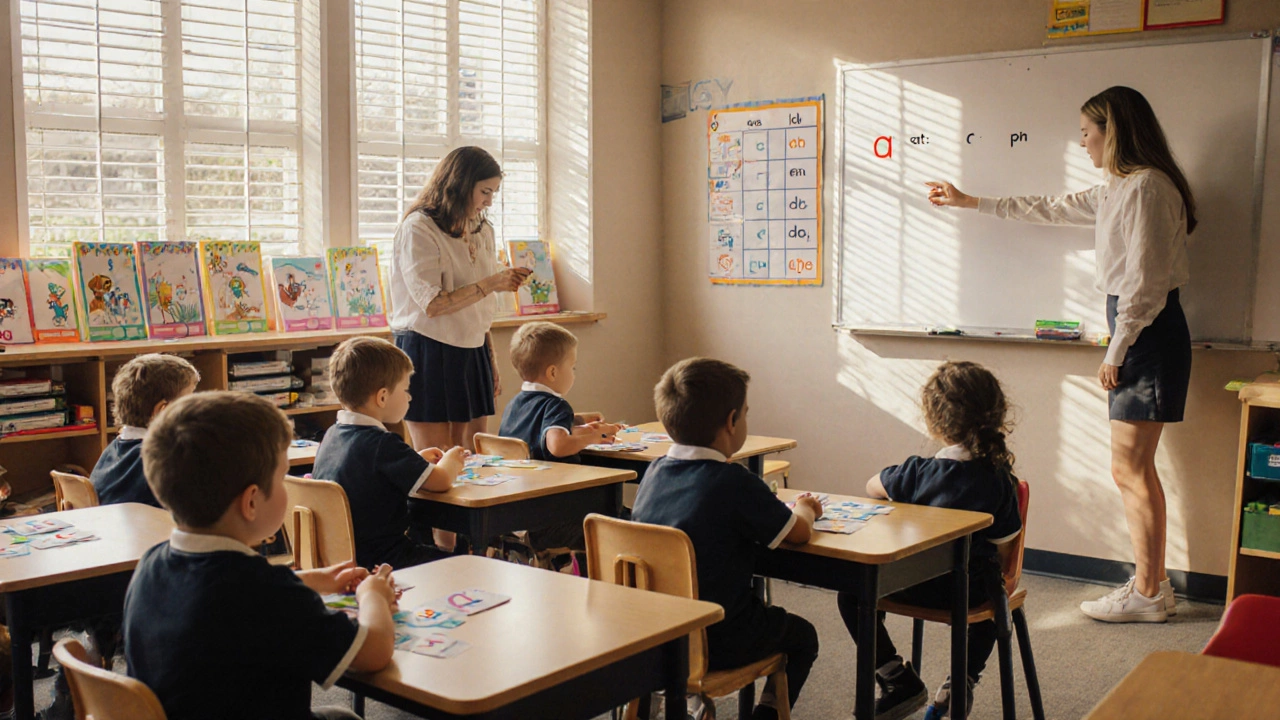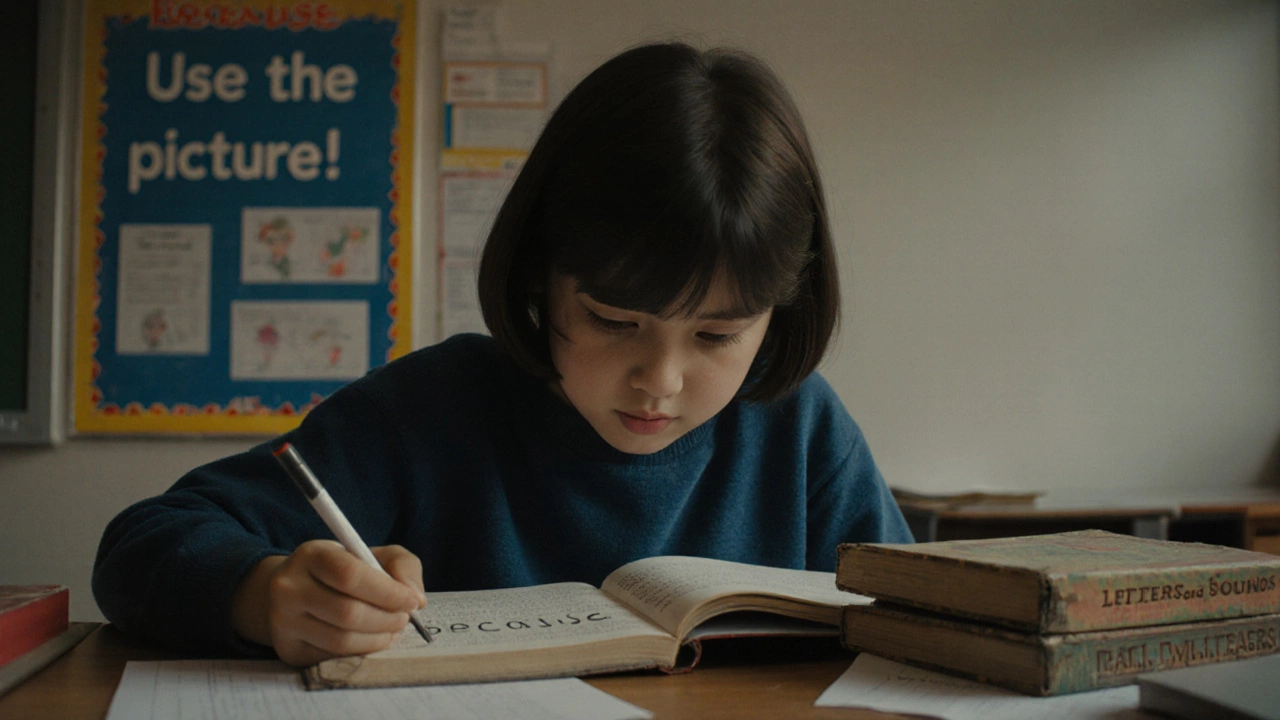Are phonics still taught in schools today?

Phonics Instruction Assessment Tool
How strong is your school's phonics instruction?
This tool assesses if your child's school follows evidence-based phonics practices. Answer the questions below to see if your school provides effective reading instruction.
Back in the 1990s, if you asked a parent how their child was learning to read, they’d likely say, "They’re doing phonics." Today, you might get a shrug. Some schools still teach it. Others don’t. And some teach it so badly, kids are left confused. So the real question isn’t whether phonics is still taught-it’s whether it’s taught well, consistently, and with enough support to actually work.
What phonics actually is (and what people think it is)
Phonics isn’t just sounding out letters. It’s the systematic teaching of how written letters connect to spoken sounds. The letter "c" makes a /k/ sound in "cat," but a /s/ sound in "city." The combination "th" can be voiced like in "this" or voiceless like in "think." Phonics teaches these patterns so kids can decode unfamiliar words instead of guessing from pictures or context.
That’s different from the old "whole language" method, where kids memorized sight words and learned to read by immersion. Whole language assumed kids would naturally pick up decoding rules by reading lots of books. But research from the National Reading Panel in 2000 showed that didn’t work for a lot of kids-especially those with learning differences or from low-income homes. Phonics, when done right, closes that gap.
Where phonics is still the standard
In Australia, the government made phonics mandatory in all public schools starting in 2023. Every Year 1 student now takes a national phonics screening check. If a child can’t blend simple words like "sat," "pin," or "dog," they get extra support. That’s not just policy-it’s backed by data. In the first year of the program, the percentage of students meeting the phonics benchmark jumped from 58% to 79%.
The same shift is happening in England. Since their phonics screening check began in 2012, reading outcomes for 6-year-olds have steadily improved. In the U.S., states like Mississippi saw dramatic gains after adopting a science-of-reading approach that centers phonics. Between 2013 and 2019, fourth-grade reading scores in Mississippi rose faster than in any other state. Teachers there now spend 90 minutes a day on structured literacy: phonics, phonemic awareness, vocabulary, fluency, and comprehension-all in sequence.
Where phonics is missing or mixed up
But not everywhere. In many U.S. school districts, teachers still use balanced literacy-a hybrid model that mixes phonics with guessing strategies. Kids might be told to "look at the picture," "think about what makes sense," or "skip the word and come back." These tricks work for simple books with clear illustrations. But they fail when kids hit harder texts. A child who’s never learned how to break down "elephant" or "thunder" doesn’t suddenly figure it out in third grade.
One teacher in Chicago told me her district still uses a popular reading program that spends 80% of time on comprehension and vocabulary, and only 20% on decoding. She said, "I’ve got kids in fifth grade who can’t read ‘because’ or ‘because’ is too hard to sound out. They’ve been reading for three years and still don’t know how to spell ‘said’ correctly. They’ve memorized it, but they don’t know why it’s spelled that way."
That’s the problem with half-measures. Phonics isn’t a supplement. It’s the foundation. If you don’t build it right, everything else crumbles.

Why some schools resist phonics
It’s not that teachers don’t want to teach phonics. Most do. The problem is training. Many teacher education programs still emphasize whole language. A 2023 study from the University of Melbourne found that 62% of pre-service teachers in Australia had never been taught the science of reading in their degree. They learned to love books, not how to teach decoding.
Curriculum publishers also play a role. Many reading programs still market themselves as "balanced" or "child-centered"-words that sound nice but mean vague, unstructured lessons. These programs come with colorful posters, themed readers, and story-based activities. They feel warm and nurturing. But they don’t give kids the tools they need.
And then there’s the myth: "Phonics is boring." It’s not. It’s logic. It’s puzzles. It’s watching a child go from "I can’t read this" to "I just figured out ‘shark’ by myself." That’s magic. But magic needs structure.
What good phonics instruction looks like
Good phonics isn’t flashcards and drills. It’s intentional, cumulative, and connected to real reading.
- It starts with single letters and sounds: /s/, /a/, /t/, /p/, /i/, /n/
- Then moves to blending: "s-a-t" becomes "sat"
- Then teaches common patterns: "igh," "ee," "oa," "ch," "sh"
- It introduces exceptions gradually: "the," "was," "said"-but only after kids know the rules
- It uses decodable books-stories built only from sounds kids have learned
- It’s daily, short (15-20 minutes), and repeated until mastery
One school in Brisbane started using a phonics program called "Letters and Sounds" with Year 1 students. Within six months, 85% of kids could read 30 high-frequency words with 90% accuracy. The kids who struggled most-those with speech delays or who spoke another language at home-made the biggest gains. Why? Because phonics doesn’t assume prior knowledge. It gives everyone the same key to unlock words.
What happens when phonics is skipped
Children who don’t learn phonics early often become reluctant readers. They avoid books because reading feels like a puzzle they can’t solve. By Grade 3, the gap widens. Kids who decode well read more. Kids who can’t decode read less. Less reading means smaller vocabularies, weaker comprehension, and lower confidence.
A 2024 study from the Australian Council for Educational Research tracked 1,200 students from Kindergarten to Year 4. Those who scored below average on phonics screening in Year 1 were four times more likely to be reading below grade level by Year 4-even if they had strong verbal skills or came from homes with lots of books.
It’s not about intelligence. It’s about access. Phonics gives every child access to the written word.

What parents can do
You don’t need to be a teacher to help. Here’s what actually works:
- Ask your child’s school: "Do you use a structured phonics program? What’s the name of it?"
- Ask: "Do students practice blending sounds every day?"
- Watch for decodable books at home. If all the books are picture-heavy and full of sight words, ask for more structured materials.
- Play sound games: "What’s the first sound in ‘dog’?" "Can you make a word with /b/, /a/, and /t/?"
- Don’t rely on apps that just flash words. Look for ones that teach blending, like "Phonics Hero" or "Reading Eggs."
And if your child is struggling, don’t wait. Early intervention works. By Grade 2, it’s harder to catch up. But in Grade 1? With the right help, most kids can turn things around.
Is phonics the only thing kids need?
No. Phonics is the foundation, but reading is more than decoding. Kids also need vocabulary, background knowledge, and comprehension strategies. But you can’t teach comprehension to a child who can’t read the words on the page.
Think of it like learning to drive. You don’t start by navigating city traffic. You start with the pedals, the steering wheel, the mirrors. Once you know how the car works, then you drive. Phonics is the steering wheel.
The bottom line
Phonics isn’t outdated. It’s evidence-based. It’s not about rigid rules or boring drills. It’s about giving every child a fair shot at reading. And if we’re serious about literacy, we can’t afford to keep ignoring it.
Some schools still teach phonics well. Others don’t. The difference isn’t about funding or technology. It’s about whether schools believe every child can learn to decode-if they’re taught the right way.
Is phonics still taught in Australian schools?
Yes, phonics is now mandatory in all Australian public schools as of 2023. Every Year 1 student takes a national phonics screening check. Schools must provide extra support to students who don’t meet the benchmark. The goal is for every child to be able to blend simple CVC words like "cat," "pin," and "dog" by the end of Year 1.
Why did some schools stop teaching phonics?
Many schools switched to "balanced literacy" in the 1990s and 2000s, which mixed phonics with guessing strategies like using pictures or context clues. This approach was popular because it felt more natural and child-centered. But research showed it didn’t work for struggling readers. Teachers often weren’t trained in phonics, so they defaulted to what they’d learned in university-even if it wasn’t effective.
Can kids learn to read without phonics?
Some can-especially those with strong verbal skills, rich language exposure at home, or who memorize words visually. But many others, especially those with learning differences or from low-income backgrounds, fall behind. Without phonics, reading becomes a guessing game. By third grade, those gaps become permanent unless addressed.
What’s the difference between phonics and whole language?
Phonics teaches kids to decode words by connecting letters to sounds. Whole language assumes kids will learn to read naturally by being surrounded by books and stories. Whole language doesn’t systematically teach letter-sound relationships. Research shows phonics is far more effective for early readers, especially those who struggle.
How do I know if my child’s school teaches phonics well?
Ask if they use a structured literacy approach with daily phonics lessons. Look for decodable books-stories made only from sounds they’ve learned. Check if kids are practicing blending sounds every day. If they’re mostly reading picture books and memorizing words, the program may not be strong enough. The best programs teach phonics in a clear sequence and assess progress regularly.
